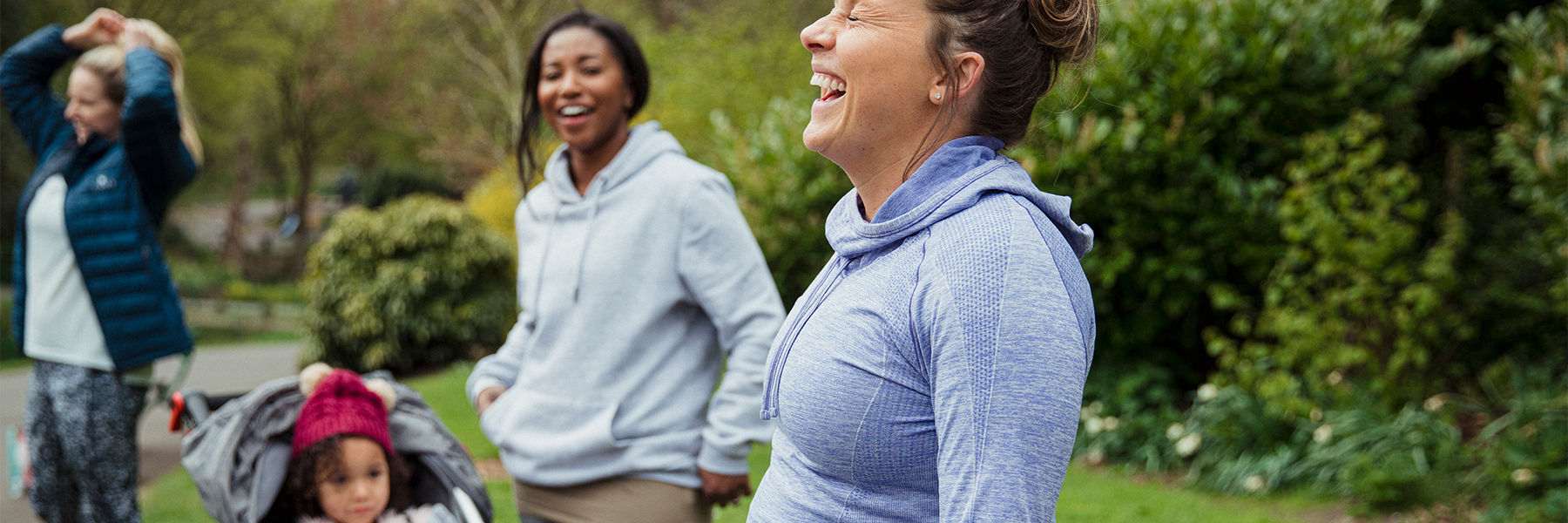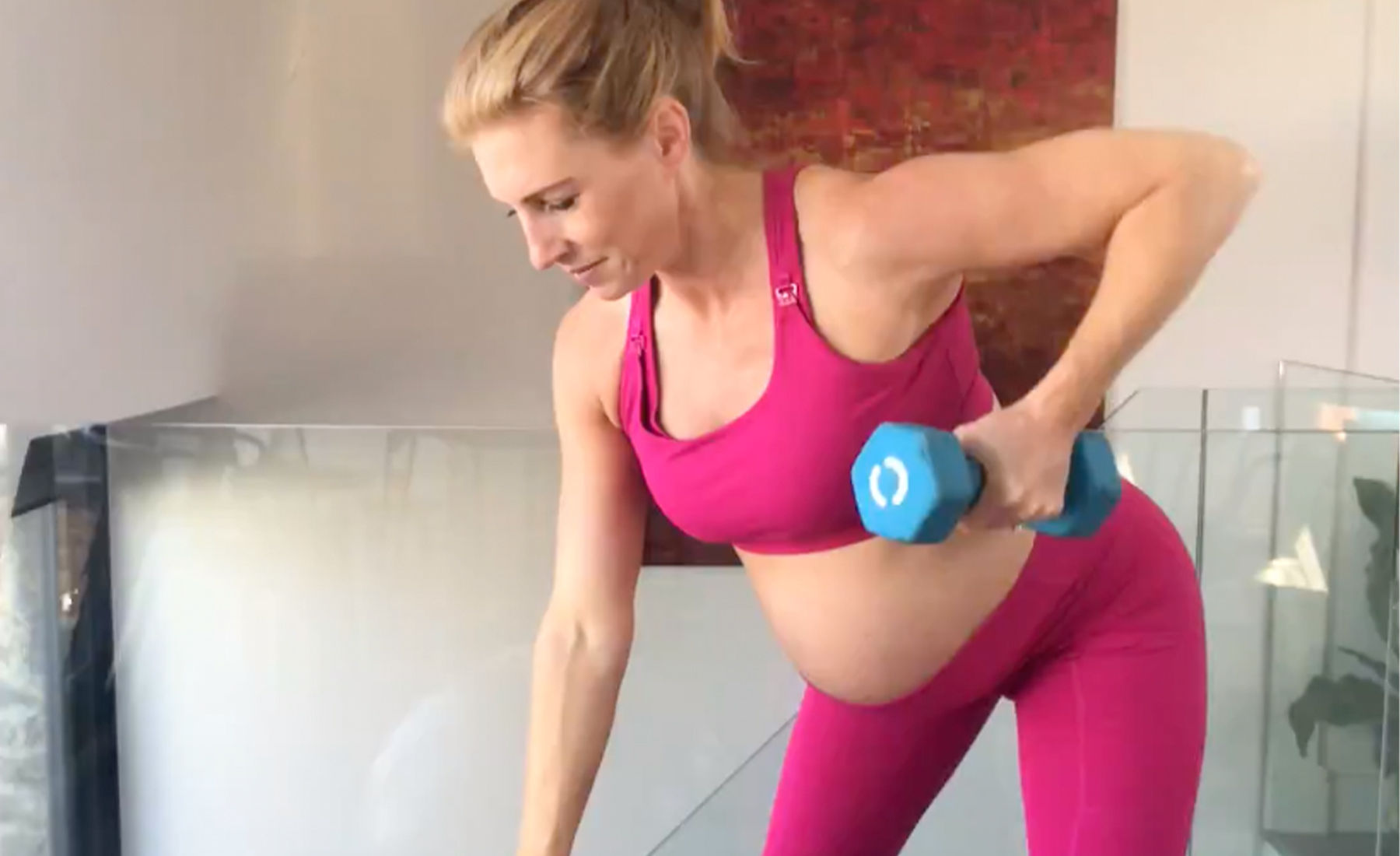Use arrow keys to navigate through the menu items. Use Tab key to navigate through the menu banners.
Pregnancy Exercise

Pregnancy Exercise
Pregnancy fitness expert Rosie Stockley shares tips on how to exercise safely and enjoy the benefits!
I’m Rosie, a personal trainer, mum to two little girls and the founder of Mamawell. My mission is to help women stay fit through pregnancy and beyond.
Staying active during pregnancy is so beneficial for your physical and mental health. It can help your body prepare for labour, boost your energy levels, lift your mood, and help you sleep better.
What are the guidelines for exercising during pregnancy?
Gone are the days when pregnant women were considered fragile and told they should rest throughout their pregnancy. The NHS recommends that adults aged 19 to 64 – including pregnant women – get 150 minutes of moderate physical activity each week and do strengthening activities that work all the major muscle groups (legs, hips, back, abdomen, chest, shoulders, and arms) on at least two days a week.
Moderate activity will raise your heart rate, and make you breathe faster and feel warmer: think brisk walking, dancing, or an exercise class.
Examples of muscle-strengthening activities include yoga, Pilates and lifting weights. Carrying heavy shopping bags and lifting and carrying children also count!
‘Gentle exercise during pregnancy is good (and safe) for you and your baby,’ says the NHS.
Should I join an exercise class?
Before attending an exercise class, check that the teacher is qualified to teach pregnant women. They should change some of the exercises so that they are suitable for you, not just tell you to take things more slowly. Even better, join a class designed for pregnant women, such as pregnancy yoga or pregnancy Pilates.
“I wanted to try and stay active in my pregnancy to prepare for birth and life with a newborn. I found a local pregnancy yoga class which I believe helped with labour. It was also a great way to meet other mums-to-be!” says Lauren Bradley, mum to Harry, three months.
How to exercise safely during pregnancy
If you're new to exercising or haven't done it in a while, now is a great time to start. You can begin with 10 minutes of daily activity, like a brisk walk, and then work your way up to 150 minutes a week. It’s okay to take it slowly and do what feels comfortable. Even a little exercise is better than none!
And if you're already doing regular exercise, that's fantastic. Just remember to listen to your body and not push yourself too hard: you should be able to have a conversation while exercising.
During pregnancy, always follow these guidelines:
-
Avoid contact sports and high-risk activities like skiing, riding and gymnastics
-
Stop exercising if you experience any unusual symptoms
-
Skip hot yoga and don't exercise in hot weather
-
Stay hydrated and avoid lying flat on your back for long periods, especially after the fourth month
-
Be cautious with unbalanced exercises and stay within your normal range of motion.
It’s important to get the go-ahead from your doctor or midwife before starting or continuing any exercise programme during pregnancy.
With these tips, you can safely exercise during pregnancy and feel better both physically and mentally.

Rosie Stockley exercising while pregnant
Pregnancy activity ideas
-
Walking is probably the easiest way to improve your activity levels during pregnancy. If you are still working, take a walk at lunchtime or while taking work calls. The NHS app Active 10 encourages you to walk briskly and tracks the total minutes you walk each day.
-
Pregnancy yoga is a great way to connect with your body and calm your mind. Pregnancy yoga uses modified positions suitable for expectant women and emphasises breathing, stretches and strengthening moves that help your body prepare for labour.
-
Pregnancy Pilates focuses on the abdominals, back, and pelvic floor. Prenatal Pilates increases body awareness and helps to prepare your body for labour.
-
Swimming puts less pressure on your joints as the water supports your weight. It’s a great form of cardio exercise and it’s also a good way of keeping active if you have back pain or pelvic girdle pain.
-
Aquanatal classes are great if you enjoy exercising in water. Not to be confused with aqua aerobics, the exercises are designed for pregnancy and are a good way to meet other parents-to-be.
-
Running can be continued if you were running before pregnancy. However, you may find that it becomes uncomfortable. In that case, switch to lower-impact cardio, such as swimming or walking.
-
Weights are a good way of keeping your body strong, which can be helpful for labour and recovery after birth. If you’re already lifting weights, you can continue, but avoid heavy weights – you should be able to lift without straining. Seek advice from your GP or midwife if you want to start lifting weights during pregnancy. Resistance bands and bodyweight exercises tailored for pregnancy are also great ways to keep your muscles strong.
-
Exercise balls can be used for exercise and during labour, so they are a handy piece of kit. Using an exercise ball is a great way to challenge your abdominals as it’s unstable, plus you can use it as a prop for stretching.
-
Housework If you don’t have the time or the inclination for dedicated exercise, there are many ways to weave activity into your daily life, from playing with your little ones to doing chores around the house. Even a fast-paced tidy-up can get you out of breath, especially if you change the sheets!
Affordable exercise gear
You don’t need a fancy gym membership, designer exercise outfits, or expensive equipment to exercise during pregnancy. You can find high-quality, affordable activewear from George at Asda. If you are going to exercise at home, ensure you have a mat and a good supportive sports bra as your first essentials. If you’re aiming to walk more, it’s worth investing in a pair of comfortable trainers. By keeping active, you’re doing a great thing for your body and mind!
Help & Customer service
- Help Centre
- How to shop
- Product recalls
Payment Methodslist with 8 items
- Asda Group of Companies
- Modern Slavery Statement
- Electrical Waste Recycling
- Terms & Conditions
- Customer Review Policy
- Privacy Centre
- Cookie Settings
- Accessibility
© ASDA 2025